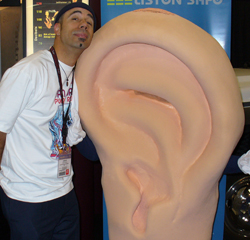
IEM Enters The Picture
There are two broad classes of IEM earpieces: custom-made, one-piece; and modular, where the output transducer is coupled to the earpiece.
Custom-made units are created from ear-mold impressions of the user’s ear, and typically, have greater bandwidth, which is perceived as superior in terms of overall sound quality.
Modular earpieces, on the other hand, can have a custom-made ear-mold or can use foam or silicone to create “one-size-fits-all” earpieces.
Their bandwidth is typically more limited and may provide a poorer signal to noise ratio across the bandwidth.
Since the development of IEM, many manufacturers have recommended it as a method of improving fidelity for performers while decreasing overall stage volumes.
While it’s true that IEM offers the advantages of being tiny, light weight and providing significant improvement over stage wedges in terms of overall fidelity (due to the proximity of the amplifier to the eardrum), it has yet to be demonstrated whether IEM can be successfully used as a method of hearing conservation.
In hearing literature, as well as in some consumer-based audio magazines, many authors regularly cite the superior acoustic isolation provided by custom-made earpieces versus modular models. However, no actual data has been published to date to substantiate most if any of these claims.
At the same time, IEM does provide several obvious benefits including increased mobility on stage, individualized mixes with individual volume controls on the performers belt-pack, and differing amounts of acoustic isolation from amplifiers.
Of course, acoustic isolation can also present a problem for the performer. Most commercially available IEM systems don’t allow easy communication between performers, since they don’t include microphones or transmitters. The earpiece needs to be taken out and re-inserted in order to talk onstage. This can be an inconvenience.
Another complaint often mentioned is that the acoustic isolation gives the listener the sensation of isolation from the audience. This is usually remedied by mixing an ambient mic into each performer’s mix.
